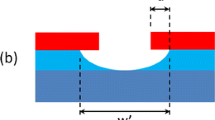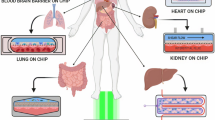Abstract
Contemporary microarrayers of contact or non-contact format used in protein microarray fabrication still suffer from a number of problems, e.g. generation of satellite spots, inhomogeneous spots, misplaced or even absent spots, and sample carryover. In this paper, a new concept of non-contact sample deposition that reduces such problems is introduced. To show the potential and robustness of this pressure-assisted deposition technique, different sample solutions known to cause severe problems or to be even impossible to print with conventional microarrayers were accurately printed. The samples included 200 mg mL–1 human serum albumin, highly concentrated sticky cell adhesion proteins, pure high-salt cell-lysis buffer, pure DMSO, and a suspension of 5-μm polystyrene beads. Additionally, a water-immiscible liquid fluorocarbon, which was shown not to affect the functionality of the capture molecules, was employed as a lid to reduce evaporation during microarray printing. The fluorocarbon liquid lid was shown to circumvent hydrolysis of water-sensitive activated surfaces during long-term deposition procedures.






Similar content being viewed by others
References
Hoheisel JD (2006) Nat Rev Genet 7:200
Plomin R, Schalkwyk LC (2007) Dev Sci 10:19
Ng JK, Liu WT (2006) Analytical and bioanalytical chemistry 386:427
Wang L, Luhm R, Lei M (2007) Adv Exp Med Biol 593:105
MacBeath G (2002) Nat Genet 32(Suppl):526
Templin MF, Stoll D, Schwenk JM, Potz O, Kramer S, Joos TO (2003) Proteomics 3:2155
Schwenk JM, Poetz O (2003) Screening 5:36
Angres B (2005) Expert review of molecular diagnostics 5:769
Lipshutz RJ, Fodor SP, Gingeras TR, Lockhart DJ (1999) Nat Genet 21:20
Wolber PK, Collins PJ, Lucas AB, De Witte A, Shannon KW (2006) Methods Enzymol 410:28
Baum M, Bielau S, Rittner N, Schmid K, Eggelbusch K, Dahms M, Schlauersbach A, Tahedl H, Beier M, Guimil R, Scheffler M, Hermann C, Funk JM, Wixmerten A, Rebscher H, Honig M, Andreae C, Buchner D, Moschel E, Glathe A, Jager E, Thom M, Greil A, Bestvater F, Obermeier F, Burgmaier J, Thome K, Weichert S, Hein S, Binnewies T, Foitzik V, Muller M, Stahler CF, Stahler PF (2003) Nucleic Acids Res 31:e151
Reineke U, Volkmer-Engert R, Schneider-Mergener J (2001) Curr Opin Biotechnol 12:59
Gao X, Zhou X, Gulari E (2003) Proteomics 3:2135
Martinsky R (2000) TeleChem International Inc., Microarray printing device including printing pins with flat tips and exterior channel and method of manufacture, Patent US6101946
Mace Jr ML, Montagu J, Rose SD, McGuinness GM (2000) In: Schena M (eds) Microarray biochip technology. Eaton Publishing, Natick, MA, pp 39–64
Tisone TC, Tonkinson JL (2005) In: Schena M (eds) Protein microarrays. Jones and Bartlett, Sudbury, MA, pp 169
Williams DF, Askill IN, Smith R (1985) J Biomed Materi Res 19:313
Martinsky T (2004) PharmaGenomics
Schober A, Gunther R, Schwienhorst A, Doring M, Lindemann BF (1993) BioTechniques 15:324
Rose (2000) In: Schena M (eds) Microarray biochip technology. Eaton Publishing, Natick, MA, pp 19
Gast F, Fiehn H (2003) Lab Chip 3:6N
Gutmann O, Kuehlewein R, Reinbold S, Niekrawietz R, Steinert CP, de Heij B, Zengerle R, Daub M (2005) Lab Chip 5:675
Wilson DS, Nock S (2002) Curr Opin Chem Biol 6:81
Villanueva W, Sjodahl J, Stjernstrom M, Roeraade J, Amberg G (2007) Langmuir 23:1171
Litborn E, Roeraade J (2000) J Chromatogr 745:137
Sjodahl J, Kempka M, Hermansson K, Thorsen A, Roeraade J (2005) Anal Chem 77:827
Ekins RP (1998) Clin Chem 44:2015
Ekins RP (1989) Pharm Biomed Anal J 7:155
Sheridan C (2005) Nat Biotechnol 23:3
Kumar A, Whitesides G (1993) Appl Phys Lett 63:2002
Xu J, Lynch M, Nettikadan S, Mosher C, Vegasandra S, Henderson E (2006) Sensors & Actuators: B. Chemical 113:1034
Piner RD, Zhu J, Xu F, Hong S, Mirkin CA (1999) 283:661
Wingren C, Borrebaeck CA (2007) Drug Discov Today 12:813
Hegde P, Qi R, Abernathy K, Gay C, Dharap S, Gaspard R, Hughes JE, Snesrud E, Lee N, Quackenbush J (2000) BioTechniques 29:548
McQuain MK, Seale K, Peek J, Levy S, Haselton FR (2003) Anal Biochem 320:281
Uemura S, Stjernstrom M, Sjodahl J, Roeraade J (2006) Langmuir 22:10272
Riess JG, Krafft MP (1998) Biomaterials 19:1529
Kuschel C, Steuer H, Maurer AN, Kanzok B, Stoop R, Angres B (2006) Biotechniques 40:523
Flaim CJ, Chien S, Bhatia SN (2005) Nat Methods 2:119
Seurynck-Servoss SL, White AM, Baird CL, Rodland KD, Zangar RC (2007) Anal Biochem 371:105
Ma H, Horiuchi KY (2006) Drug Discov Today 11:661
Acknowledgements
We thank Sylvia Adam and Heiko Steuer (both NMI) for performing the cell adhesion assays. This work was funded by the European Union as part of the program “Nanobiotechnology with Self-Organising Structures (NABIS)”, contract no. NMP4-CT-2003–505311. Financial support from the Swedish Research Council is also gratefully acknowledged.
Author information
Authors and Affiliations
Corresponding author
Rights and permissions
About this article
Cite this article
Hartmann, M., Sjödahl, J., Stjernström, M. et al. Non-contact protein microarray fabrication using a procedure based on liquid bridge formation. Anal Bioanal Chem 393, 591–598 (2009). https://doi.org/10.1007/s00216-008-2509-7
Received:
Revised:
Accepted:
Published:
Issue Date:
DOI: https://doi.org/10.1007/s00216-008-2509-7




